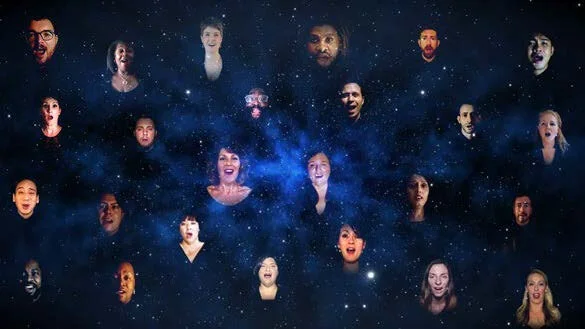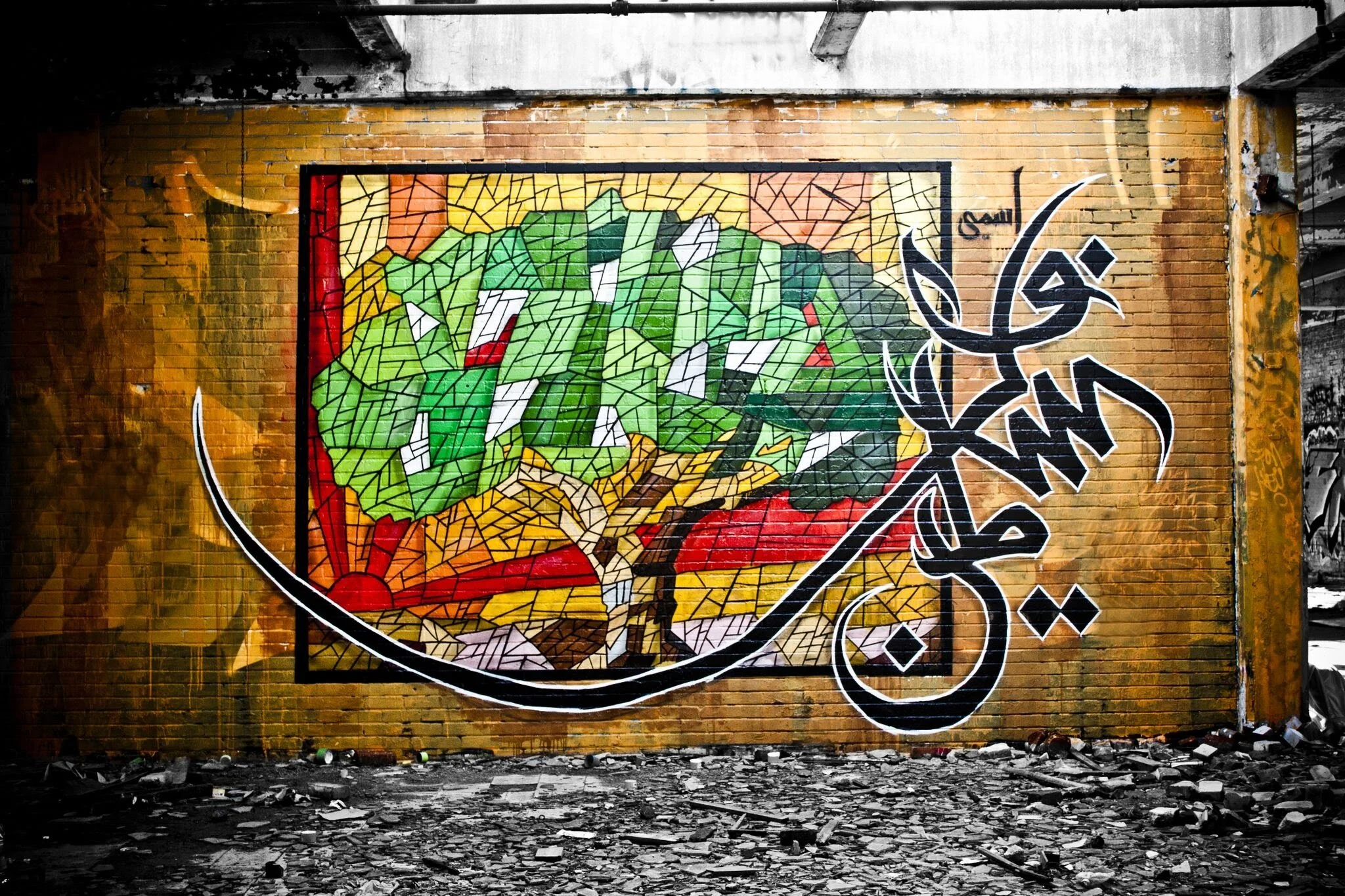Despite these unique times, artists are finding creative ways to reach people during the pandemic.
Positive artwork. PeterPunk-Fotolia. CC2.5 España
Although the COVID-19 pandemic has turned the entire world upside down, it has been particularly hard on artists. With live performances and galleries being closed due to public health guidelines, the future of arts and cultural institutions remains in jeopardy. Despite these trying times, artists are channeling their creativity to reach people in new ways while spreading uplifting messages about resilience and hope. Here are eight examples from around the world:
1. UNHCR in Geneva solidarity concert
A view of Geneva from the UNHCR headquarters. Fruchterman. CC2.0
On May 28, violinists Stefan Arzberger and Claire Dassesse joined with viola player Sophie Speyer to give a concert in the completely empty Geneva headquarters of the United Nations High Commissioner for Refugees (UNHCR).The musicians honored their commitment to helping refugees and internally displaced people around the world, who are especially vulnerable during these uncertain times. The Global Compact on Refugees through the UNHCR emphasizes the power of music on refugees’ well-being, promoting peaceful coexistence. Violinist Stefan Arzberger stated that “we all have a role to play” in times like these, while emphasizing, “At a time when we are told to keep our physical distance, [music] also reminds us that we are bound by a human connection beyond distance or borders.” Arzberger has also participated in other musical and humanitarian initiatives, including a program which brings classical music to refugees in Jordan.
2. Conspirare Unity Concert
A snapshot from the “Unity” concert by Conspirare. Ann McNair. CC2.0
With the name originating from the Latin for “to breathe together,” the Austin, Texas-based choral ensemble Conspirare is made up of some of the best professional vocalists in the United States. On Oct. 30 and Nov. 1, Conspirare released a livestream of their new concert called “Unity,” bringing awareness to the numerous social problems gripping the United States including the coronavirus pandemic, racial injustice and political turmoil. Soprano Sonja Tengblad, who sings with Conspirare, voiced that the concert’s message of support for Black Lives Matter was incredibly moving to her, saying, "There were layers of BLM symbolism woven through the entire program, in addition to putting our Black and Brown colleagues' voices at the forefront of the whole concert." Although Tengblad mentioned the many difficulties of preparing for a concert virtually, she also cited the added bonus of the increased possibility of artistic expression that the medium allows, including adding the visual elements of protest signs and an electronic reconstruction of an amphitheater to the performance. Despite social isolation, communicating virtually allows limitless possibilities to be creative. A link to the concert livestream can be found here.
3. ResiliArt Movement by UNESCO
Audrey Azoulay, the head of UNESCO. UNESCO Headquarters Paris. CC2.0
On World Art Day, Audrey Azoulay, the head of UNESCO, said in an address, “Bringing people together, inspiring, soothing and sharing: these are the powers of art, the importance of which has been made emphatically obvious during the COVID-19 pandemic.” The UNESCO-coined hashtag #ShareCulture hopes to invoke more conversations about the arts to bring people together. In order to support arts and cultural institutions around the world, UNESCO has also launched the ResiliArt movement, hosting online debates among artists from around the world, emphasizing the importance of “listen[ing] to the voices of the artistic world in their globality and diversity.”. With these efforts, UNESCO also hopes to increase the accessibility of arts to the public.
4. Kenyan artists showing off Indigenous resilience
The painting “Alone in Blue” by Kenyan artist Moses Wanyuki. Schaffer. CC3.0
The Kenya-based nonprofit Trust for Indigenous Culture and Health launched an initiative to allow artists to sell their work and spread messages of support and resilience in response to COVID-19. Forty-six artists came together to build a mobile art installation, which is predicted to be open for another month. Visual artist Peterson Kamwathi, who participated in the installation, said that the project was “an opportunity for artists to come together and collaboratively create something that depicts their presence and their continuity through this art.” He, along with many others, found “an opportunity to bring our work, I think, in a very grand way into the public space."
5. Artists in the Middle East exhibiting creativity
The work “My Name Is Palestine” by artist eL Seed in Montreal. Berrehouma. CC3.0
The arts scene in the Middle East has been heavily affected during the pandemic, with major event Art Dubai being closed last spring. Nevertheless, artists and cultural institutions are finding ways to be creative. Tunisian-French street artist eL Seed created a “Zoom mural” with 49 participants from around the world, each displaying an artistic piece as their background. The calligraphy on the picture above is a quote from French author Andre Malraux: “Art is the shortest path from one human being to another human being.” The United Arab Emirates’ government supported artists by buying $400,000 worth of artwork when Art Dubai was canceled. Dubai’s art district of Alserkal is taking various efforts to support its artistic community, waiving three months of rent for all galleries and donating 300 meals a day. Many artists have agreed that creative expression is more important now than ever before. According to Lebanese filmmaker Nadine Labaki, “The mission and power of art is to change, and even if it doesn’t ignite change, it ignites debate.” Berlin-based Syrian artist Khaled Barakeh states that, “If we really want to use art and creativity for social change, it’s the time, and it should start now.”
6. Arab singers spreading messages of gratitude
Egyptian singer Dina El Wedidi. Davidson. CC3.0
Singers from across the Arab world have been releasing songs celebrating doctors and medical teams fighting the pandemic. Some songs include Medhat Saleh’s recording “The People in the White Coat” along with the piece “Our Country’s Heroes,” a collaboration by Egyptian folk singer Mohamed Adawya and Moroccan singer Jannat. Around 12 of these songs have been produced in Egypt, many of which have somewhat of a nationalistic bent to them. According to Yasmine Farrag, professor of art critique at Arts Academy, these pieces are considered “songs of the situation” that fit with the present time.
7. Street art around the world sends awareness
A mural supporting the National Health Service in England. MTaylor848. CC4.0
With the absence of galleries, many artists are turning to street art to stretch their creative muscles while raising awareness about the coronavirus pandemic. In England, paintings that depict the National Health Service and nurses as heroes abound. Many murals from around the world seek to raise awareness about personal hygiene and social distancing, such as one of washing hands with soap in Dakar, Senegal. Many murals in countries such as Kenya, Germany, Brazil, the Czech Republic and the U.S. depict individuals wearing masks, including one of trumpet player Louis Armstrong in New Orleans. In India, artists in Chennai and Bangalore are creating colorful murals on roads emphasizing social distancing protocols. Last but not least is a “coronavirus-themed graffiti” in the Swiss Alps depicting a girl looking at the horizon. The piece is over 32,000 square feet and “evokes the building of a world with more solidarity and more humanity,” according to artist Guillaume Legros.
8. Yayoi Kusama responds to the COVID-19 crisis with poetry
Japanese artist Yayoi Kusama. Wikimedia Commons. CC4.0
Often nicknamed the “princess of polka dots” and known for her unique sculptures, installations and paintings, the 91-year-old Japanese artist Yayoi Kusama wrote a moving poem in response to the worldwide effects of the coronavirus. Although she refers to hope as “glisten[ing] just out of reach,” she remains optimistic, mentioning a “burst of light” that “points to the future.” Kusama goes on to emphasize that “now is the time for people all over the world to stand up.” The full text of the poem and a preview of one of her exhibitions “Infinity Mirrored Room” can be viewed here.
Through varying mediums, artists around the world are expressing messages of hope and social awareness. In a time of such turbulence, artists are embracing their creative spirits and bringing some much-needed life.
Megan Gürer
Megan is a Turkish-American student at Wellesley College in Massachusetts studying Biological Sciences. Passionate about environmental issues and learning about other cultures, she dreams of exploring the globe. In her free time, she enjoys cooking, singing, and composing music.










